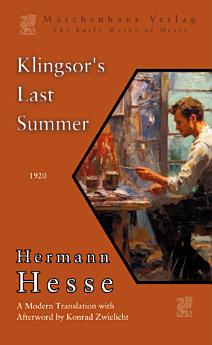Klingsor's Last Summer
Jan 1970 · The Early Works of Hermann Hesse Book 14 · Marchen Press
Ebook
217
Pages
family_home
Eligible
info
reportRatings and reviews aren’t verified Learn More
About this ebook
In 1920, Hesse published Klingsors letzter Sommer (“Klingsor’s Last Summer”), a vibrant novella that stands as one of his most passionate and colorful works. Set against the backdrop of Switzerland’s postwar neutrality, this novella channels the era’s frenetic escapism. Published by S. Fischer Verlag, it depicts an aging painter’s desperate creativity in the shadow of influenza pandemics and economic collapse. Klingsor’s hedonistic pursuit of beauty—vividly rendered in expressionist prose—mirrors the Weimar Republic’s cabaret culture and its flight from collective trauma. Hesse’s own retreat to Ticino, away from Germany’s turmoil, infuses the narrative with exile’s dual liberation and isolation. The book was released by S. Fischer in Berlin, rounding out what one might consider a trilogy of significant post-war Hesse publications (Demian in 1919, Klingsor and Wandering in 1920, followed by Siddhartha in 1922). Klingsor’s Last Summer is a story suffused with intensity—it chronicles the final summer in the life of a fictional 42-year-old expressionist painter named Klingsor, who, sensing that death might be near (or at least the death of his youthful creative energy), throws himself into a feverish season of painting, loving, and living to the fullest. The character Klingsor can be seen as a composite of Hesse himself and some of his painter friends (Hesse had taken up watercolor painting around that time and befriended artists like Louis Moilliet). The novella has a strong autobiographical undercurrent: Hesse was also 42 when he wrote it, and he was in the throes of change—he’d separated from his wife, was living in the southern Swiss village of Montagnola, painting landscapes, and exploring a more bohemian existence. The “last summer” signifies a burst of creative freedom and sensual indulgence before a turning point. Klingsor’s Last Summer was very well received in the German literary world. It solidified Hesse’s reputation as a writer who could channel the zeitgeist of the 1920s: the hunger for life after the dark war years, and the expressionist ethos of emotional intensity. This new edition features a fresh, contemporary translation of Hesse's classic work, making his philosophical, existentialist literature accessible to modern readers from the original Fraktur manuscripts. Enhanced by an illuminating Afterword focused on Hesse's personal and intellectual relationship with Carl Jung, a concise biography, a glossary of essential philosophical terms integral to his writings (his version of Jungian Psychological concepts) and a detailed chronology of his life and major works, this robust edition introduces the reader to the brilliance of his literature in context. It not only captures the depth and nuance of Hesse’s thought but also highlights its enduring impact on the debates of the mid-20th century, contemporary culture and Western Philosophy across the 20th and into the 21st century.
About the author
Herman Hesse (1877-1962) navigated a life shaped by psychological turbulence that fundamentally transformed his literary vision following his pivotal encounter with Carl Jung's analytical psychology. After suffering a severe breakdown in 1916 amid his crumbling first marriage and the ravages of World War I, Hesse underwent intensive psychoanalysis with Jung's student J.B. Lang and later with Jung himself, sessions that would profoundly alter his creative trajectory. This Jungian influence became evident in his subsequent works, particularly "Demian" and "Steppenwolf," where the protagonist's journey toward individuation—Jung's concept of integrating the conscious and unconscious aspects of personality—emerges as a central theme. Hesse's correspondence with Jung continued for decades, their intellectual relationship deepening as Hesse increasingly incorporated Jungian archetypes, dream symbolism, and the notion of the shadow self into his narratives of spiritual seeking. The writer later acknowledged that Jung's therapeutic methods had not only rescued him from psychological collapse but had fundamentally reshaped his understanding of human consciousness, enabling him to transmute his personal suffering into the allegorical quests for wholeness that characterized his most enduring works.RetryClaude can make mistakes. Please double-check responses.
Rate this ebook
Tell us what you think.
Reading information
Smartphones and tablets
Install the Google Play Books app for Android and iPad/iPhone. It syncs automatically with your account and allows you to read online or offline wherever you are.
Laptops and computers
You can listen to audiobooks purchased on Google Play using your computer's web browser.
eReaders and other devices
To read on e-ink devices like Kobo eReaders, you'll need to download a file and transfer it to your device. Follow the detailed Help Center instructions to transfer the files to supported eReaders.










